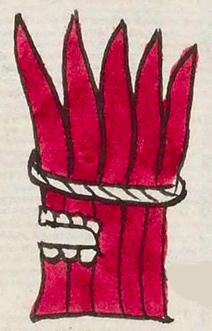Cuezallan (Mdz6r)
This compound glyph for the place name Cuezallan consists of two principal components. The scarlet macaw tail feathers (cuezalin) are the predominant feature. Five feathers are visible, and they have a white, twisted tie holding them together. The feathers are standing upright, with the tips at the top. These tips are not turquoise blue, as they appear in some other glyphs. The teeth (tlantli) are the phonetic indicator for the locative suffix, -tlan, place of, rather than -tla (or -tlah), place of abundance of.
Stephanie Wood
The bundling of the feathers with the rope or string might recall the verb cueza, to baste a garment together, underscoring the reading of cuezalin over, perhaps, ihuitl (feathers). These precious feathers had an association with fire, and therefore the deity of fire, as well as the deity associated with death. See: Alfredo López Austin, Los mitos del tlacuache: caminos de la mitología mesoamericana (1996), 194. Note the flame (tletl), below on the right. Two other examples of cuezalin feathers also appear below, right.
Gordon Whittaker, in Deciphering Aztec Hieroglyphs, 2021, 102, has discovered that the full set of teeth (top and bottom) are used when the ligature -ti- appears before the locative suffix -tlan. This is an exception.
Stephanie Wood
cueçalan. puo
Cuezallan, pueblo
Stephanie Wood
c. 1541, or by 1553 at the latest
Stephanie Wood
feathers, birds, teeth, tie, atar, plumas, pájaros, dientes, nombres de lugares

cuezal(in), red macaw tail feathers, https://nahuatl.wired-humanities.org/content/cuezalin
tlan(tli), tooth/teeth, https://nahuatl.wired-humanities.org/content/tlantli
-tlan, by, near, among, https://nahuatl.wired-humanities.org/content/tlan
"Scarlet Macaw Feather Place" [Frances Karttunen, unpublished manuscript, used here with her permission.]
"Where There Are Many Scarlet Macaw Feathers" (Berdan and Anawalt, 1992, vol. 1, p. 182)
"Lugar de las Plumas del Guacamayo Macao"
Stephanie Wood
Codex Mendoza, folio 6 recto, https://digital.bodleian.ox.ac.uk/objects/2fea788e-2aa2-4f08-b6d9-648c00..., image 22, of 188.
The Bodleian Libraries, University of Oxford, hold the original manuscript, the MS. Arch. Selden. A. 1. This image is published here under the UK Creative Commons, “Attribution-NonCommercial-ShareAlike 3.0 License” (CC-BY-NC-SA 3.0).





